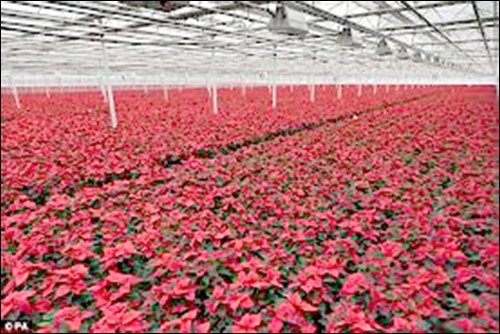As the holiday season approaches, the garden centres and other retail outlets are ablaze with holiday plants. The most traditional holiday plant is, of course, the poinsettia. These amazing plants in their native setting are actually rather large shrubs. It is simply amazing to see these plants we associate with winter merrily blooming in climates known for their sand and sun. In their natural form they are a large, leggy shrub that is adorned with the lovely red blooms on the ends of the branches.
The familiar Christmas poinsettia is a member of the large group of plants known as Euphorbias. The group displays extreme variability in growth habit, from succulent types so cactus-like in appearance that one member of the group was given the botanical name Euphorbia pseudocactus to leafy spurge (Euphorbia esula) a noxious weed in Saskatchewan.
However, the Christmas poinsettia (Euphorbia pullcherrima) is the most famous member of this diverse group of relatives. The common feature linking all these plants together is there inconspicuous but distinct flowers. The red “flowers” of a poinsettia plant are not actually flowers at all, but merely bright red leaves arranged in star-like clusters at the ends of the branches. The bright bracts are designed to draw pollinating insects toward the inconspicuous yellow flowers in their centre.
The word “bract” is a botanical term for any leaf that has lost its normal photosynthetic role to take on a more specialized role. If you observe of any poinsettia “flower” carefully, you’ll find at least a couple of leaves that are partially green and partially coloured. These were caught mid-way when the plant switched into “flowering mode” and began changing new developing leaves into coloured bracts.
As short-day plants, poinsettias initiate flowering after exposure to an eight-week period where nights are at least 14 hours long. Commercial growers bringing them into flower for Christmas are therefore careful to assure the plants experience nights of at least this length, hardly difficult during a Saskatchewan winter!
In Mexico where these plants are native, poinsettias form shrubs several meters high. These bloom in winter and produce the characteristic red bracts. From these shrubs, smaller selections with particularly large showy bracts have been selected and bred. Red is the traditional colour, but pink and white selections have now been available for some years. Most recently, mottled variations of pink have also hit the market. Whether you view this as an improvement, or as something that looks like it might have been the result of a red sock being accidentally left in the washing machine, is a matter of taste.
The goal of most people is simply getting the poinsettia through most of the winter in presentable condition. Begin by purchasing a healthy plant with large well-coloured bracts and making sure that the small true flowers are still present at the tips of the stems. If the small yellow flowers are missing, the plant is not fresh.
It should be properly wrapped and taken directly home to avoid excess chilling, which can cause sudden leaf drop. Keep the plant at normal room temperature, away from drafts in bright filtered light. Direct sunlight from an east or west window is not too bright, but a sheer curtain should filter the light from a direct southern exposure.
Water thoroughly when the potting soil has dried slightly. Most poinsettias are sold with a plastic sleeve to hide the pot and protect furniture from dripping water. Within a half-hour after watering the sleeve should be removed and emptied so that the plant is not left standing in water. There is little need for fertilizer during the Christmas season since most growers will have included a slow-release fertilizer in the growing medium. Provided with bright light and even moisture, most poinsettia plants should remain attractive for months.
— Hanbidge is a horticulturist with the Saskatoon School of Horticulture and can be reached at 306-931-GROW(4769); by email at growyourfuture@gmail.com or check out our website at www.saskhort.com.



